This article's lead section may not adequately summarize its contents.(August 2023) |
Canid hybrids are the result of interbreeding between the species of the subfamily Caninae .
This article's lead section may not adequately summarize its contents.(August 2023) |
Canid hybrids are the result of interbreeding between the species of the subfamily Caninae .
The wolf-like canids are a group of large carnivores that are genetically closely related because they all possess 78 chromosomes, arranged in 39 pairs and are karyologically indistinguishable from each other. [1] [2] : p279 [3] The group includes the genera Canis, Cuon, Lupulella and Lycaon. The members are the domestic dog (C. lupus familiaris), gray wolf (C. lupus), dingo (C. lupus dingo), coyote (C. latrans), golden jackal (C. aureus), African wolf (C. lupaster), Ethiopian wolf (C. simensis), dhole (Cuon alpinus), black-backed jackal (Lupulella mesomelas), side-striped jackal (L. adusta) and African wild dog (Lycaon pictus). [4] Newly proposed members include the red wolf (Canis rufus), and the eastern wolf (Canis lycaon), subject to a resolution of the dispute as to whether these constitute separate species in their own right or whether they are sub-species of the gray wolf. The members of Canis can potentially interbreed, [5] however, it is believed that Cuon, Lupulella and Lycaon cannot breed with each other or with Canis. [6] [7] The Lupulella genus (the side-striped jackal and black-backed jackal), [8] could theoretically interbreed with each other to produce fertile offspring, but a study of the maternal mitochondrial DNA of the black-backed jackal could find no evidence of genotypes from its most likely mate, the side-striped jackal, indicating that male black-backed jackals had not bred with their sister species. [9]
When the differences in number and arrangement of chromosomes is too great, hybridization becomes less and less likely. Other members of the wider dog family, Canidae, such as South American canids, true foxes, bat-eared foxes, or raccoon dogs which diverged 7 to 10 million years ago, are less closely related to the wolf-like canids, have fewer chromosomes and cannot hybridize with them. [3] (recently proven, partly incorrect, see pampas fox with dog below) For instance, the red fox has 34 metacentric chromosomes and from 0 to 8 small B chromosomes, [10] the raccoon dog has 42 chromosomes, and the fennec fox has 64 chromosomes.

The domestic dog (Canis familiaris) is a domesticated species of the gray wolf (Canis lupus), along with the dingo (Canis familiaris). Therefore, crosses between these species are biologically unremarkable and not a hybridization in the same sense as an interbreeding between different species of Canidae.
Wolves are different from domestic dogs in that wolves usually have slimmer chests, longer legs, and they also have stronger jaws than those of the domestic dog subspecies. [11] The difference in appearance from the wolf to the domestic dog becomes even larger when a mix of the two animals is created. Wolfdogs do not have one common description of their appearance because it varies from one breeding cycle to the next. [11] It differs from cycle to cycle because the number of wolf genes inherited in the animal differs greatly and is recorded in a percentage form. The general layout for describing the percentage of wolfdogs is as follows: 1-49% is considered low content (LC), 50-74% is considered to be mid-content (MC), and 75% and higher is considered to be high content (HC).[ citation needed ] The percentage of the amount of wolf in a wolfdog decides what the animal will look like. For example, if a wolfdog is 25% husky and 75% wolf, it will appear more like a wolf than a husky because it contains more genes from the wolf. [12] This means that the appearance of the wolfdog will most likely contain a narrower chest, longer legs, and sharper teeth because it inherited more traits from the wolf parent. [12]
People wanting to improve domestic dogs or create an exotic pet may breed domestic dogs to wolves. Gray wolves have been crossed with dogs that have a wolf-like appearance, such as German Shepherds to form the Czechoslovakian Wolfdog. The breeding of wolf–dog crosses is controversial, with opponents purporting that it produces an animal unfit as a domestic pet. A number of wolfdog breeds are in development. The first generation crosses (one wolf parent, one dog parent) generally are backcrossed to domestic dogs to maintain a domestic temperament and consistent conformation.
Coydogs (the offspring of a male coyote and a female domestic dog) are naturally occurring red or blond color variations of the coyote and feral dogs. The breeding cycles of domestic dogs and coyotes are not synchronized and this makes interbreeding uncommon. If interbreeding had been common, each successive generation of the coyote population would have acquired more and more dog-like traits.
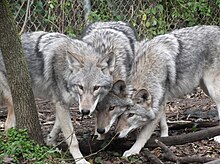
Hybridization between gray wolves and coyotes has long been recognized both in the wild and in captivity. In an evolutionary biology research conducted by a team of researchers in the Uppsala University, analysis of control region haplotypes of the mitochondrial DNA and sex chromosomes from Mexican wolves, a critically endangered subspecies of the gray wolf once nearly driven to extinction in the wild, confirmed the presence of coyote markers in some of the wolves. [13] The study suggests that at some point in time, female coyotes managed to mate with some of the male wolves of the remnant wild Mexican wolf populations. Analysis on the haplotype of some coyotes from Texas also detected the presence of male wolf introgression, such as Y chromosomes from the gray wolves in the southern coyotes. In one cryptozoological investigation on a corpse of what was initially labelled as a chupacabra, examinations conducted by the UC Davis team and the Texas State University concluded based on the sex chromosomes that the male animal was in fact another coyote and wolf hybrid sired by a male Mexican wolf. [14]
DNA analysis consistently shows that all existing red wolves carry coyote genes. This has caused a problem for canid taxonomy, as hybrids are not normally thought of as species, though the convention is to continue to refer to red wolves as a subspecies of the gray wolf, Canis lupus rufus, with no mention of the coyote taxon latrans. [15] [16]
In recent history, the taxonomic status of the red wolf has been widely debated. Mech (1970) suggested that red wolves may be fertile hybrid offspring from gray wolf (Canis lupus) and coyote (C. latrans) interbreeding. Wayne and Jenks (1991) and Roy et al. (1994b, 1996) supported this suggestion with genetic analysis. Phillips and Henry (1992) present logic supporting the contention that the red wolf is a subspecies of the gray wolf. However, recent genetic and morphological evidence suggests that the red wolf is a unique taxon. Wilson et al. (2000) report that gray wolves (Canis lupus lycaon) in southern Ontario appear genetically very similar to the red wolf and that these two canids may be subspecies of one another and not a subspecies of gray wolf. Wilson et al. (2000) propose that red wolves and C. lupus lycaon should be a separate species, C. lycaon, with their minor differences acknowledged via subspecies designation. North American wolf biologists and geneticists also concluded that C. rufus and C. lupus lycaon were genetically more similar to each other than either was to C. lupus or C. latrans (B. T. Kelly, unpubl.). In 2002, morphometric analyses of skulls also indicate that the red wolf is likely not to be a gray wolf–coyote hybrid (Nowak 2002). Therefore, while the red wolf's taxonomic status remains unclear, there is mounting evidence to support C. rufus as a unique canid taxon. [17]
Classifying animals commonly referred to as "eastern coyotes" or "northeastern coyotes" has become a problem for taxonomists, as it is unclear what new taxon will be used to refer to this new population of animals. [18]
The Ethiopian wolf's conservation is threatened by dog hybridisation. [19]
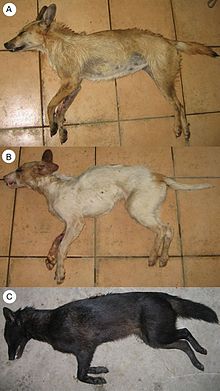
Although hybridization between wolves and golden jackals has never been observed, evidence of such occurrences was discovered through mtDNA analysis on jackals in Bulgaria. [21] Although there is no genetic evidence of gray wolf-jackal hybridization in the Caucasus Mountains, there have been cases where otherwise genetically pure golden jackals have displayed remarkably gray wolf-like phenotypes, to the point of being mistaken for wolves by trained biologists. [22]
Several years ago, I saw confined in the Zoological Gardens of London a female hybrid from an English dog and jackal, which even in this the first generation was so sterile that, as I was assured by her keeper, she did not fully exhibit her proper periods; but this case, from numerous instances have occurred of fertile hybrids from these two animals, was certainly exceptional. [23]

Crossings between canids of a different genus is extremely rare. In 2021, a female canid with unusual phenotypic characteristics was found in Vacaria City, Rio Grande do Sul, Brazil. DNA analysis indicates that the canid was a hybrid between a pampas fox and a domestic dog. [26] Dubbed a 'dogxim' or 'graxorra', [27] this finding is the first documented case of hybridisation detected between these two species. [26]
The examples and perspective in this article deal primarily with the United States and do not represent a worldwide view of the subject.(July 2020) |
Dog hybrids kept as pets are prohibited in certain jurisdictions, or are classed as wild animals and must be housed in the same way as purebred wolves.
In the United States, legislation differs greatly from state to state. In New York, the law does not allow an individual to house or own a dog hybrid of any kind, even if there is a low percentage of wolf genes in the hybrid. [12] States such as Indiana and Arkansas allow the ownership of hybrid animals, but they regulate it strictly with health records, immunization records, and registration of the animal, [28] while other states, such as Arizona, do not have any laws about owning a wolfdog hybrid. [28] States may or may not create their own laws regarding the issue of wolfdog hybrids.

Canidae is a biological family of dog-like carnivorans, colloquially referred to as dogs, and constitutes a clade. A member of this family is also called a canid. The family includes three subfamilies: the extant Caninae and the extinct Borophaginae and Hesperocyoninae. The Caninae are known as canines, and include domestic dogs, wolves, coyotes, foxes, jackals and other extant and extinct species.

There are 38 subspecies of Canis lupus listed in the taxonomic authority Mammal Species of the World. These subspecies were named over the past 250 years, and since their naming, a number of them have gone extinct. The nominate subspecies is the Eurasian wolf.

Jackals are medium-sized canids native to Africa and Eurasia. While the word "jackal" has historically been used for many canines of the subtribe canina, in modern use it most commonly refers to three species: the closely related black-backed jackal and side-striped jackal of sub-Saharan-Africa, and the golden jackal of south-central Europe and Asia. The African golden wolf was also formerly considered as a jackal.
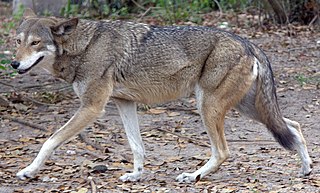
The red wolf is a canine native to the southeastern United States. Its size is intermediate between the coyote and gray wolf.

The wolf, also known as the gray wolf or grey wolf, is a large canine native to Eurasia and North America. More than thirty subspecies of Canis lupus have been recognized, including the dog and dingo, though gray wolves, as popularly understood, only comprise naturally-occurring wild subspecies. The wolf is the largest extant member of the family Canidae, and is further distinguished from other Canis species by its less pointed ears and muzzle, as well as a shorter torso and a longer tail. The wolf is nonetheless related closely enough to smaller Canis species, such as the coyote and the golden jackal, to produce fertile hybrids with them. The wolf's fur is usually mottled white, brown, gray, and black, although subspecies in the arctic region may be nearly all white.

Canis is a genus of the Caninae which includes multiple extant species, such as wolves, dogs, coyotes, and golden jackals. Species of this genus are distinguished by their moderate to large size, their massive, well-developed skulls and dentition, long legs, and comparatively short ears and tails.

A wolfdog is a canine produced by the mating of a domestic dog with a gray wolf, eastern wolf, red wolf, or Ethiopian wolf to produce a hybrid.

The eastern wolf also known as the timber wolf, Algonquin wolf or eastern timber wolf, is a canine of debated taxonomy native to the Great Lakes region and southeastern Canada. It is considered to be either a unique subspecies of gray wolf or red wolf or a separate species from both. Many studies have found the eastern wolf to be the product of ancient and recent genetic admixture between the gray wolf and the coyote, while other studies have found some or all populations of the eastern wolf, as well as coyotes, originally separated from a common ancestor with the wolf over 1 million years ago and that these populations of the eastern wolf may be the same species as or a closely related species to the red wolf of the Southeastern United States. Regardless of its status, it is regarded as unique and therefore worthy of conservation with Canada citing the population in eastern Canada as being the eastern wolf population subject to protection.

The golden jackal, also called common jackal, is a wolf-like canid that is native to Southeast Europe, Central Asia, Western Asia, South Asia, and regions of Southeast Asia. The golden jackal's coat varies in color from a pale creamy yellow in summer to a dark tawny beige in winter. It is smaller and has shorter legs, a shorter tail, a more elongated torso, a less-prominent forehead, and a narrower and more pointed muzzle than the Arabian wolf. It is listed as Least Concern on the IUCN Red List due to its widespread distribution and high density in areas with plenty of available food and optimum shelter.

A coydog is a canid hybrid resulting from a mating between a male coyote and a female dog. Hybrids of both sexes are fertile and can be successfully bred through for generations. Similarly, a dogote is a hybrid with a dog father and a coyote mother.

Coywolf is an informal term for a canid hybrid descended from coyotes, eastern wolves, gray wolves, and dogs. All members of the genus Canis are closely genetically related with 78 chromosomes and therefore can interbreed. One genetic study indicates that these two species genetically diverged relatively recently. Genomic studies indicate that nearly all North American gray wolf populations possess some degree of admixture with coyotes following a geographic cline, with the lowest levels occurring in Alaska, and the highest in Ontario and Quebec, as well as Atlantic Canada. Another term for these hybrids is sometimes wolfote.

The side-striped jackal is a canine native to central and southern Africa.
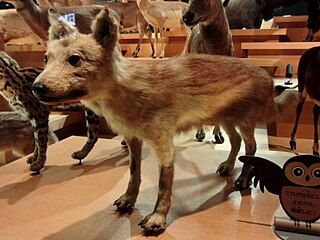
The Japanese wolf, also known as the Honshū wolf, is an extinct subspecies of the gray wolf that was once endemic to the islands of Honshū, Shikoku and Kyūshū in the Japanese archipelago.

A black wolf is a melanistic colour variant of the gray wolf. Black specimens were recorded among red wolves, though the colour morph in this species is probably now extinct. Genetic research from the Stanford University School of Medicine and the University of California, Los Angeles revealed that wolves with black pelts owe their distinctive coloration to a mutation which occurred in domestic dogs, and was carried to wolves through wolf-dog hybridization. Besides coat and knee colour, they are normal grey wolves.
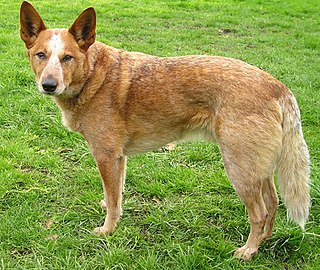
A dingo–dog hybrid is a hybrid cross between a dingo and a domestic dog. The current population of free ranging domestic dogs in Australia is now probably higher than in the past. However, the proportion of the so-called "pure" dingoes has been on the decrease over the last few decades due to hybridisation and is regarded as further decreasing.

A jackal–dog hybrid is a canid hybrid resulting from a mating between a domestic dog and a golden jackal. Such crossbreeding has occurred numerous times in captivity and was first confirmed to occasionally happen in the wild in Croatia in 2015.

The African wolf or golden wolf, formerly known as the African golden jackal, is a canine native to North Africa, West Africa, the Sahel, northern East Africa, and the Horn of Africa. It is listed as least concern on the IUCN Red List. In the Middle Atlas in Morocco, it was sighted in elevations as high as 1,800 m (5,900 ft). It is primarily a predator of invertebrates and mammals as large as gazelle fawns, though larger animals are sometimes taken. Its diet also includes animal carcasses, human refuse, and fruit. They are monogamous and territorial; offspring remain with the parents to assist in raising their parents' younger pups.

The evolution of the wolf occurred over a geologic time scale of at least 300 thousand years. The grey wolf Canis lupus is a highly adaptable species that is able to exist in a range of environments and which possesses a wide distribution across the Holarctic. Studies of modern grey wolves have identified distinct sub-populations that live in close proximity to each other. This variation in sub-populations is closely linked to differences in habitat – precipitation, temperature, vegetation, and prey specialization – which affect cranio-dental plasticity.
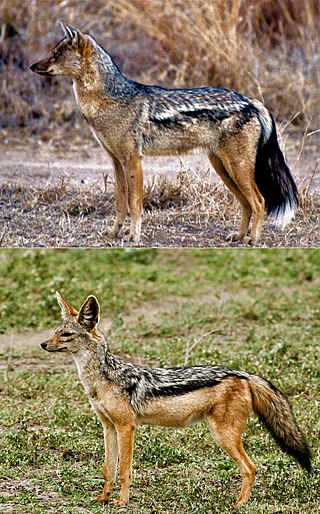
Lupulella is a genus of canine found in Africa. This genus consists of only two extant species, the black-backed jackal and the side-striped jackal.